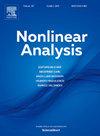Normalizing flows as approximations of optimal transport maps via linear-control neural ODEs
IF 1.3
2区 数学
Q1 MATHEMATICS
引用次数: 0
Abstract
In this paper, we consider the problem of recovering the -optimal transport map T between absolutely continuous measures as the flow of a linear-control neural ODE, where the control depends only on the time variable and takes values in a finite-dimensional space. We first show that, under suitable assumptions on and on the controlled vector fields governing the neural ODE, the optimal transport map is contained in the -closure of the flows generated by the system. Then, we tackle the problem under the assumption that only discrete approximations of of the original measures are available: we formulate approximated optimal control problems, and we show that their solutions give flows that approximate the original optimal transport map . In the framework of generative models, the approximating flow constructed here can be seen as a ‘Normalizing Flow’, which usually refers to the task of providing invertible transport maps between probability measures by means of deep neural networks. We propose an iterative numerical scheme based on the Pontryagin Maximum Principle for the resolution of the optimal control problem, resulting in a method for the practical computation of the approximated optimal transport map, and we test it on a two-dimensional example.
通过线性控制神经ode将流量归一化为最优运输图的近似
在本文中,我们考虑在绝对连续测度μ,ν∈P(Rn)之间恢复w2 -最优传输映射T的问题,作为线性控制神经ODE的流,其中控制仅依赖于时间变量并在有限维空间中取值。我们首先证明,在适当的μ,ν和控制神经ODE的矢量场的假设下,系统产生的流的cc0闭包中包含了最优传输映射。然后,我们在假设只有原始度量μ,ν的μ n, ν的离散近似可用的情况下处理问题:我们提出了近似的最优控制问题,并表明它们的解给出了近似原始最优传输映射t的流。在生成模型的框架中,这里构建的近似流可以被视为“归一化流”,这通常指的是通过深度神经网络在概率测度之间提供可逆传输映射的任务。提出了一种基于庞特里亚金极大值原理的求解最优控制问题的迭代数值格式,得到了一种近似最优运输图的实际计算方法,并在二维算例上进行了验证。
本文章由计算机程序翻译,如有差异,请以英文原文为准。
求助全文
约1分钟内获得全文
求助全文
来源期刊
CiteScore
3.30
自引率
0.00%
发文量
265
审稿时长
60 days
期刊介绍:
Nonlinear Analysis focuses on papers that address significant problems in Nonlinear Analysis that have a sustainable and important impact on the development of new directions in the theory as well as potential applications. Review articles on important topics in Nonlinear Analysis are welcome as well. In particular, only papers within the areas of specialization of the Editorial Board Members will be considered. Authors are encouraged to check the areas of expertise of the Editorial Board in order to decide whether or not their papers are appropriate for this journal. The journal aims to apply very high standards in accepting papers for publication.

 求助内容:
求助内容: 应助结果提醒方式:
应助结果提醒方式:


